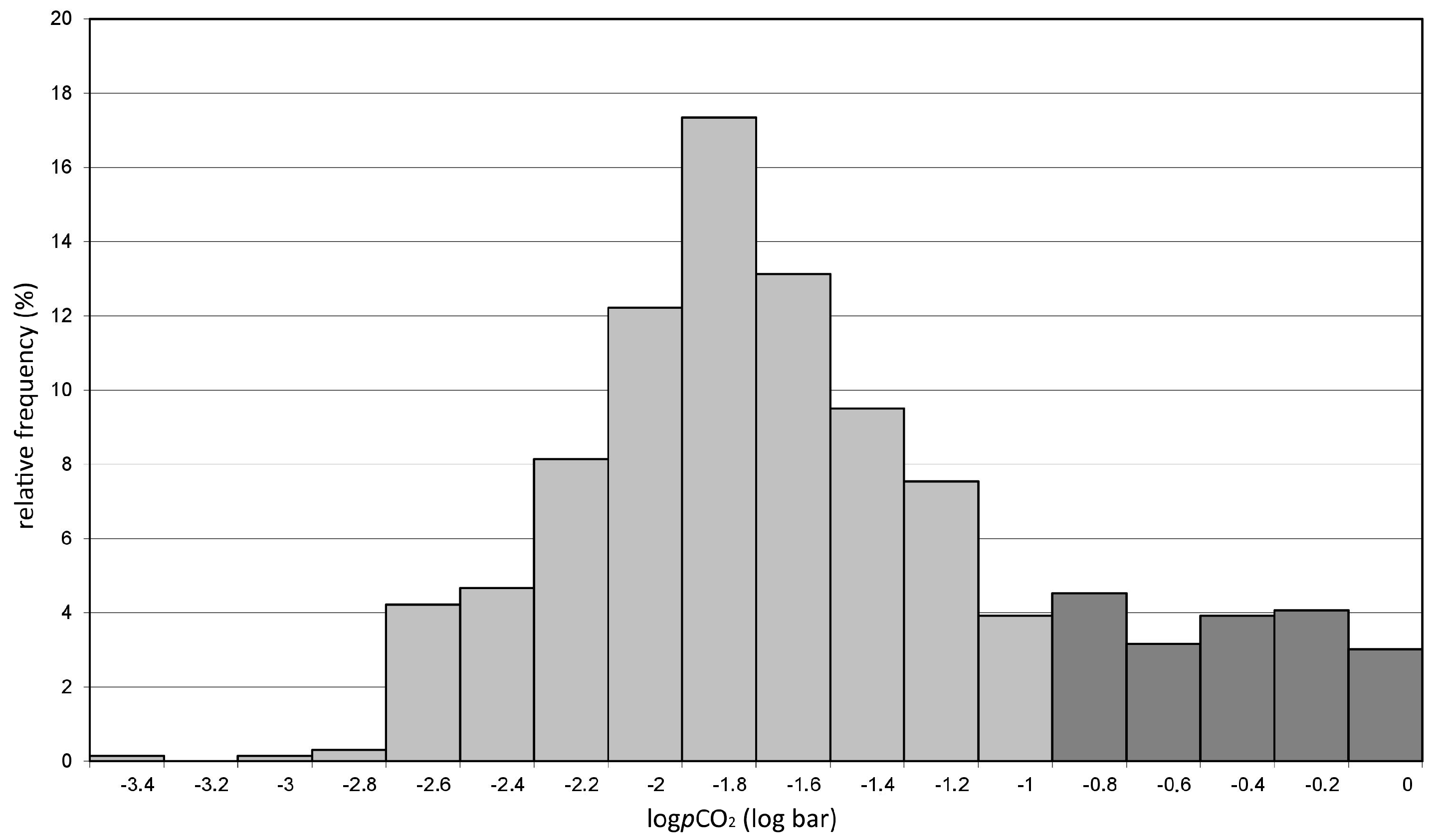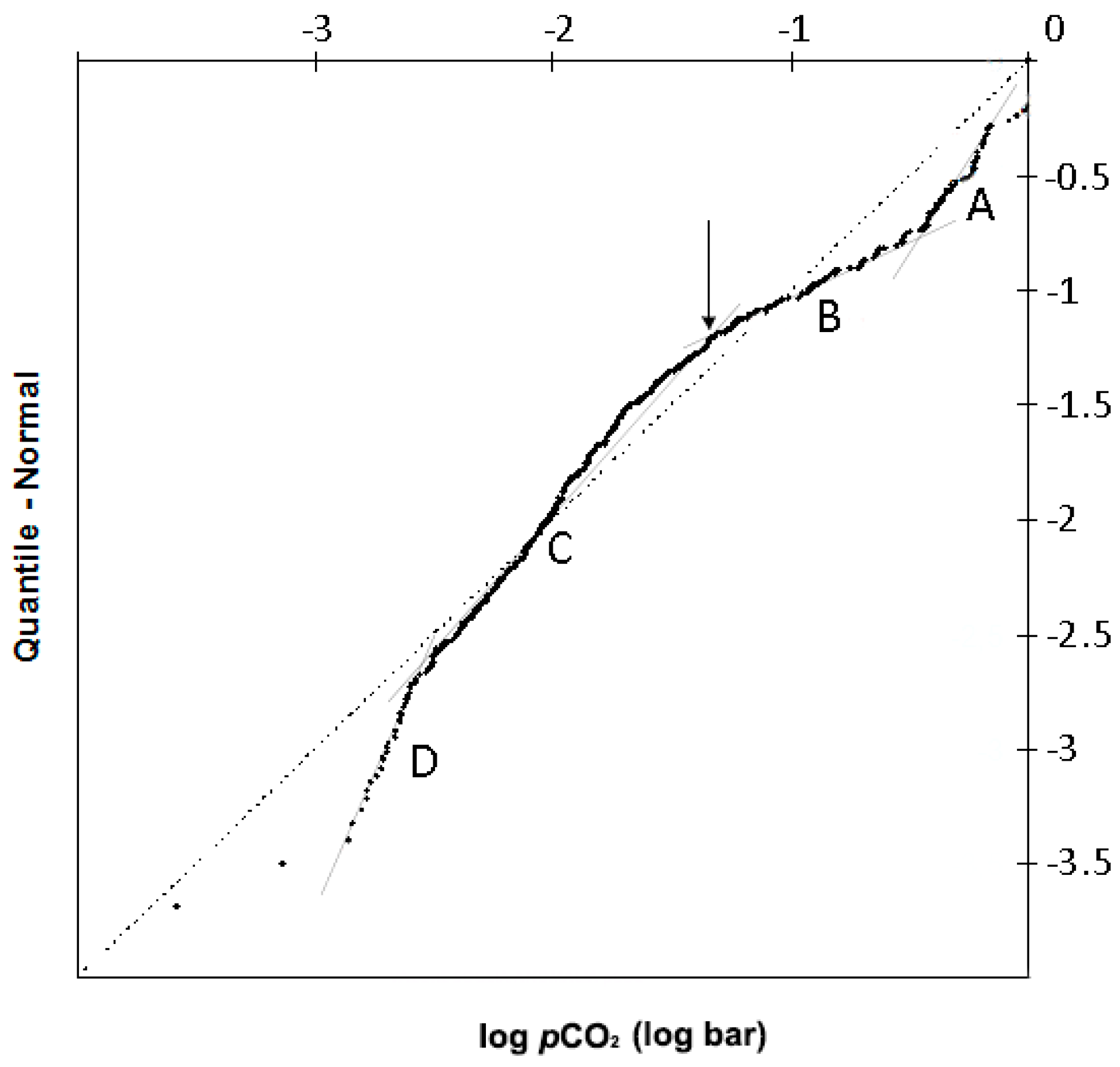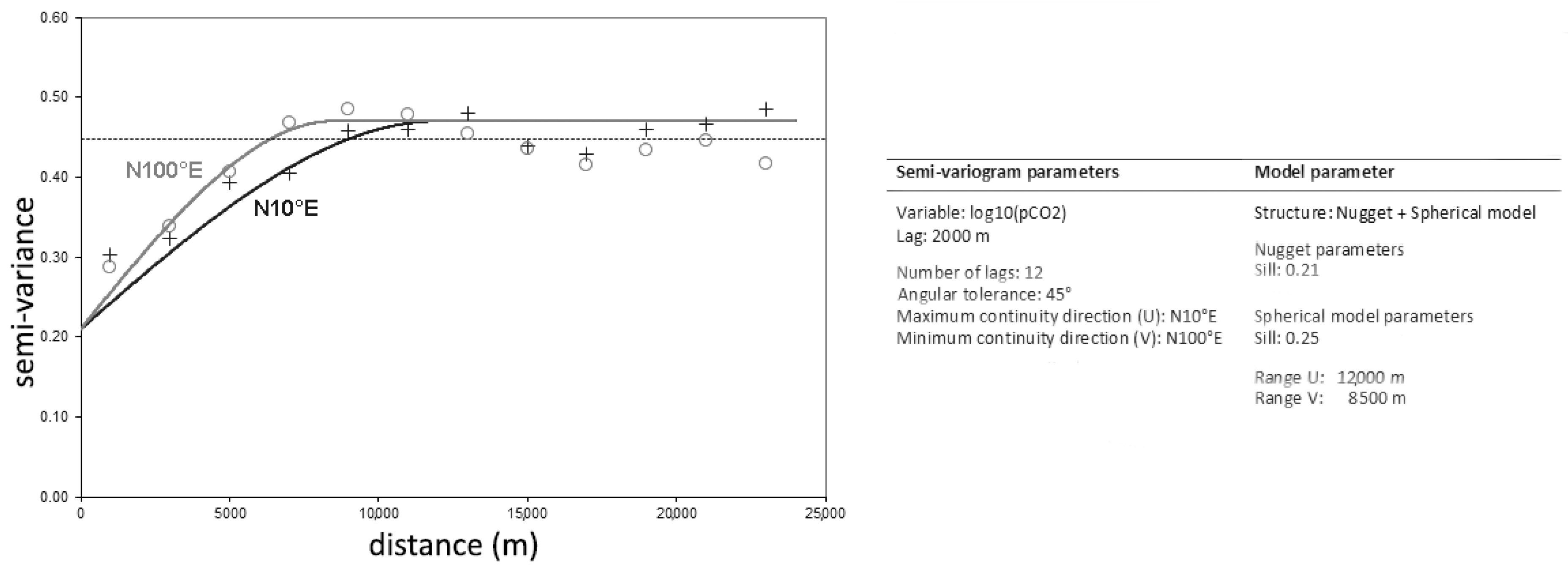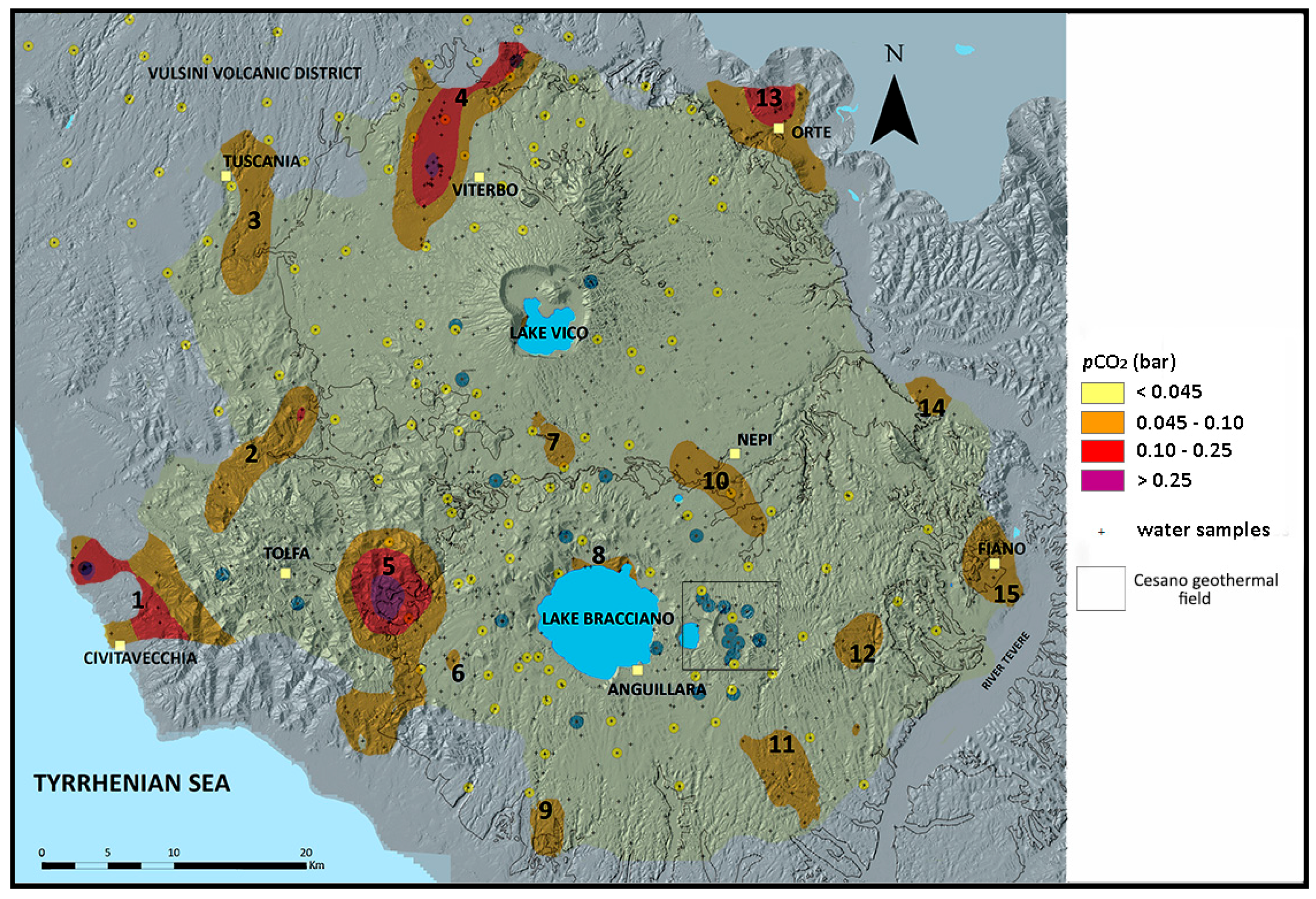Evaluation of the Theoretical Geothermal Potential of Inferred Geothermal Reservoirs within the Vicano–Cimino and the Sabatini Volcanic Districts (Central Italy) by the Application of the Volume Method
Abstract
:1. Introduction
2. Geological and Hydrogeological Background
3. Results
3.1. Basic Statistics and Geostatistical Analysis
3.2. Application of the Volume Method
4. Discussion
5. Materials and Methods
6. Conclusions
Acknowledgments
Author Contributions
Conflicts of Interest
References
- Procesi, M.; Cantucci, B.; Buttinelli, M.; Armezzani, G.; Quattrocchi, F.; Boschi, E. Strategic use of the underground in an Energy mix plan: Synergies among CO2, CH4 geological storage and geothermal Energy. Appl. Energy 2013, 110, 104–131. [Google Scholar] [CrossRef]
- Buonasorte, G.; Cameli, G.M.; Fiordelisi, A.; Parotto, M.; Perticone, I. Results of geothermal exploration in central Italy (Latium-Campania). In Proceedings of the World Geothermal Congress, Florence, Italy, 18–31 May 1995; International Geothermal Association, Inc.: Auckland, New Zealand, 1995; pp. 1293–1298. [Google Scholar]
- Cataldi, R.; Mongelli, F.; Squarci, P.; Taffi, L.; Zito, G.; Calore, C. Geothermal ranking of Italian territory. Geothermics 1995, 24, 115–129. [Google Scholar] [CrossRef]
- Cataldi, R.; Rendina, M. Recent discovery of a new geothermal field: Alfina. Geothermics 1973, 2, 106–116. [Google Scholar] [CrossRef]
- Calamai, A.; Cataldi, R.; Dall’Aglio, M.; Ferrara, G.C. Preliminary report on the Cesano hot brine deposit (northern Latium, Italy). In Proceedings of the 2nd U.N. Symposium on the Development and Use of Geothermal Energy, San Francisco, CA, USA, 20–29 May 1975; pp. 305–313. [Google Scholar]
- Borghetti, G.; La Torre, P.; Sbrana, A.; Sollevanti, F. Geothermal exploration in Monti Cimini permit (north Latium, Italy). In Proceedings of the 3rd Intern. EC Seminar European Geothermal Update, Munich, Germany, 29 November–1 December 1983; pp. 419–432. [Google Scholar]
- Bertrami, R.; Cameli, G.M.; Lovari, F.; Rossi, U. Discovery of Latera geothermal field: Problems of the exploration and research. In Proceedings of the Seminar on Utilization of Geothermal Energy for Electric Power Production and Space Heating, Florence, Italy, 14–17 May 1984; pp. 1–18. [Google Scholar]
- Carella, R.; Verdiani, G.; Palmerini, C.G.; Stefani, G.C. Geothermal activity in Italy: Present status and future prospects. Geothermics 1985, 14, 247–254. [Google Scholar] [CrossRef]
- Billi, B.; Cappetti, G.; Luccioli, F. ENEL activity in the research, exploration and exploitation of geothermal energy in Italy. Geothermics 1986, 15, 765–779. [Google Scholar] [CrossRef]
- Barberi, F.; Buonasorte, G.; Cioni, R.; Fiordalisi, A.; Iaccarino, S.; Laurenzi, M.A.; Sbrana, A.; Vernia, L.; Villa, I.M. Plio-Pleistocene geological evolution of the geothermal area of Tuscany and Latium. Mem. Descr. Carta Geol. D’Italia 1994, 49, 77–134. [Google Scholar]
- Giordano, G.; De Benedetti, A.A.; Bonamico, A.; Ramazzotti, P.; Mattei, M. Incorporating surface indicators of reservoir permeability into reservoir volume calculations: Application to the Colli Albani caldera and the central Italy geothermal province. Earth-Sci. Rev. 2014, 128, 75–92. [Google Scholar] [CrossRef]
- Ministry of Economic Development—Directorate-General for Safety of Minimg and Energy Activities (DGS-UNMIG). National Mining Office for Hydrocarbons and Georesources. Available online: http://unmig.mise.gov.it/unmig/geotermia/titoli/titoli.asp (accessed on 31 December 2017 ).
- Muffler, P.; Cataldi, R. Methods for regional assessment of geothermal resources. Geothermics 1978, 7, 53–89. [Google Scholar] [CrossRef]
- Doveri, M.; Lelli, M.; Merini, L.; Raco, B. Revision, calibration, and application of the volume method to evaluate the geothermal potential of some recent volcanic areas of Latium, Italy. Geothermics 2010, 39, 260–269. [Google Scholar] [CrossRef]
- Mahon, W.A.J.; McDowell, G.D.; Finlayson, J.B. Carbon dioxide: Its role in geothermal systems. N. Z. J. Sci. 1980, 23, 133–148. [Google Scholar]
- Marini, L.; Chiodini, G. The role of carbon dioxide in the carbonate-evaporite geothermal systems of Tuscany and Latium (Italy). Acta Vulcanol. 1994, 5, 95–104. [Google Scholar]
- Chiodini, G.; Frondini, F.; Ponziani, F. Deep structures and carbon dioxide degassing in central Italy. Geothermics 1995, 24, 81–94. [Google Scholar] [CrossRef]
- Chiodini, G.; Baldini, A.; Barberi, F.; Carapezza, M.L.; Cardellini, C.; Frondini, F.; Granieri, D.; Ranaldi, M. Carbon dioxide degassing at Latera caldera (Italy): Evidence of geothermal reservoir and evaluation of its potential energy. J. Geophys. Res. 2007, 112. [Google Scholar] [CrossRef]
- Cinti, D.; Procesi, M.; Tassi, F.; Montegrossi, G.; Sciarra, A.; Vaselli, O.; Quattrocchi, F. Fluid geochemistry and geothermometry in the western sector of the Sabatini volcanic district and the Tolfa Mountains (central Italy). Chem. Geol. 2011, 284, 160–181. [Google Scholar] [CrossRef]
- Rybach, L. Classification of geothermal resources by potential. Geotherm. Energy Sci. 2015, 3, 13–17. [Google Scholar] [CrossRef]
- Conticelli, S.; Peccerillo, A. Petrology and geochemistry of potassic and ultrapotassic volcanism in central Italy: Petrogenesis and inferences on the evolution of the mantle sources. Lithos 1992, 28, 221–240. [Google Scholar] [CrossRef]
- Cimarelli, C.; De Rita, D. Relatively rapid emplacement of dome-forming magma inferred from strain analyses: The case of the acid Latian dome complexes (Central Italy). J. Volcanol. Geotherm. Res. 2006, 158, 106–116. [Google Scholar] [CrossRef]
- Acocella, V.; Funiciello, R. Transverse systems along the extensional Tyrrhenian margin of central Italy and their influence on volcanism. Tectonics 2006, 25. [Google Scholar] [CrossRef]
- Scrocca, D.; Doglioni, C.; Innocenti, F. Constraints for an interpretation of the Italian geodynamics: A review. Mem. Descr. Carta Geol. D’Italia 2003, 62, 15–46. [Google Scholar]
- Della Vedova, B.; Bellani, S.; Pellis, G.; Squarci, P. Deep temperatures and surface heat flow distribution. In Anatomy of an Orogen: The Apennines and Adjacent Mediterranean Basins; Vai, G.B., Martini, P., Eds.; Kluwer Academic Publishers: Norwell, MA, USA, 2001; pp. 65–76. [Google Scholar]
- Serri, G.; Innocenti, F.; Manetti, P. Geochemical and petrological evidence of the subduction of delaminated Adriatic continental lithosphere in the genesis of the Neogene-Quaternary magmatism of central Italy. Tectonophysics 1993, 223, 117–147. [Google Scholar] [CrossRef]
- Peccerillo, A. Cenozoic Volcanism in the Tyrrhenian Sea Region; Springer International Publishing AG: Cham, Switzerland, 2017. [Google Scholar]
- Cioni, R.; Laurenzi, M.A.; Sbrana, A.; Villa, I.M. 40Ar-39Ar chronostratigraphy of the initial activity in the Sabatini Volcanic Complex (Italy). Boll. Soc. Geol. Ital. 1993, 112, 251–263. [Google Scholar]
- De Rita, D.; Di Filippo, M.; Rosa, C. Structural evolution of the Bracciano volcano-tectonic depression, Sabatini Volcanic District, Italy. In Volcano Instability on the Earth and Other Planets; Geological Society of London: London, UK, 1996; Volume 110, pp. 225–236. [Google Scholar]
- Laurenzi, M.A.; Villa, I.M. 40Ar/39Ar chronostratigraphy of Vico ignimbrites. Period. Miner. 1987, 56, 285–293. [Google Scholar]
- Baldi, P.; Decandia, F.A.; Lazzarotto, A.; Calamai, A. Studio geologico del substrato della copertura vulcanica laziale delle zone dei laghi di Bolsena, Vico e Bracciano. Mem. Soc. Geol. Ital. 1974, 13, 575–606. [Google Scholar]
- Capelli, G.; Mazza, R.; Gazzetti, C. Strumenti e Strategie per la Tutela e L’uso Compatibile Della Risorsa Idrica Nel Lazio: Gli Acquiferi Vulcanici; Pitagora Group: Bologna, Italy, 1995; p. 191. [Google Scholar]
- Curewitz, D.; Karson, J.A. Structural settings of hydrothermal outflow: Fracture permeability maintained by fault propagation and interaction. J. Volcanol. Geotherm. Res. 1997, 79, 149–168. [Google Scholar] [CrossRef]
- Faulds, J.E.; Hinz, N.H. Favorable tectonic and structural settings of geothermal systems in the Great Basin region, western USA: Proxies for discovering blind geothermal systems. In Proceedings of the World Geothermal Congress, Melbourne, Australia, 19–25 April 2015; p. 6. [Google Scholar]
- Buonasorte, G.; Carboni, M.G.; Conti, M.A. Il substrato plio-pleistocenico delle vulcaniti sabine: Considerazioni stratigrafiche e paleoambientali. Boll. Soc. Geol. Ital. 1991, 110, 35–40. [Google Scholar]
- Sinclair, A.J. Selection of threshold values in geochemical data using probability graphs. J. Geochem. Explor. 1974, 3, 129–149. [Google Scholar] [CrossRef]
- Matheron, G. The Theory of Regionalized Variables and Its Applications; Cahiers du Centre de Morphologie Mathematique: Fontainbleau, France, 1971. [Google Scholar]
- Goovaerts, P. Geostatistics for Natural Resources Evaluation; Oxford University Press: New York, NY, USA, 1997. [Google Scholar]
- Cinti, D.; Tassi, F.; Procesi, M.; Bonini, M.; Capecchiacci, F.; Voltattorni, N.; Vaselli, O.; Quattrocchi, F. Fluid geochemistry and geothermometry in the unexploited geothermal field of the Vicano–Cimino volcanic district (central Italy). Chem. Geol. 2014, 371, 96–114. [Google Scholar] [CrossRef]
- Cinti, D.; Tassi, F.; Procesi, M.; Brusca, L.; Cabassi, J.; Capecchiacci, F.; Delgado Huertas, A.; Galli, G.; Grassa, F.; Vaselli, O.; et al. Geochemistry of hydrothermal fluids from the eastern sector of the Sabatini Volcanic District (central Italy). Appl. Geochem. 2017, 84, 187–201. [Google Scholar] [CrossRef]
- Ranaldi, M.; Lelli, M.; Tarchini, L.; Carapezza, M.L.; Patera, A. Estimation of the geothermal potential of the Caldara di Manziana site in the Sabatini Volcanic District (central Italy) by integrating geochemical data and 3D-GIS modelling. Geothermics 2016, 62, 115–130. [Google Scholar] [CrossRef]
- The Australian Geothermal Reporting Code Committee. Australian Code for Reporting of Exploration Results, Geothermal Resources and Geothermal Reserves; The Geothermal Reporting Code, 2nd ed.; Australian Geothermal Energy Group (AGEG): Adelaide, Australia, 2010.
- Lemmon, E.W.; McLinden, M.O.; Friend, D.G. Thermophysical properties of fluid systems. In NIST Chemistry Web-Book, NIST Standard Reference Database Number 69; Linstrom, P.J., Mallard, W.G., Eds.; National Institute of Standards and Technology: Gaithersburg, MD, USA, 2003. [Google Scholar]
- Cerling, T.E.; Solomon, D.K.; Quade, J.; Bowman, J.R. On the isotopic composition of carbon in soil carbon dioxide. Geochim. Cosmochim. Acta 1991, 55, 3403–3405. [Google Scholar] [CrossRef]
- Craig, H. The isotopic geochemistry of water and carbon in geothermal areas. In Nuclear Geology on Geothermal Areas; Tongiorgi, E., Ed.; CNR (Italian Council for Research, Rome): Spoleto, Italy, 1973; pp. 17–54. [Google Scholar]
- Rollinson, H. Using Geochemical Data; Longman Group: London, UK, 1993. [Google Scholar]
- Parkhurst, D.L.; Appelo, C.A.J. Description of Input and Examples for PHREEQC Version 3—A Computer Program for Speciation, Batch-Reaction, One-Dimensional Transport, and Inverse Geochemical Calculations; U.S.G.S. Techniques and Methods, Book 6; U.S. Geological Survey: Denver, CO, USA, 2013; Chapter A43; p. 497. Available online: http://pubs.usgs.gov/tm/06/a43 (accessed on 1 June 2017).





| Statistics | pCO2 (bar) |
|---|---|
| No. of Observations | 664 |
| Minimum | 0.001 |
| Maximum | 0.98 |
| First Quartile | 0.008 |
| Median | 0.017 |
| Third Quartile | 0.055 |
| Mean | 0.089 |
| Variance (n − 1) | 0.034 |
| Standard Deviation (n − 1) | 0.184 |
| Inter Quartile Range | 0.046 |
| Skewness | 3.158 |
| Kurtosis | 10.386 |
| Area | ID | A (km2) | h (km) | V (km3) | Q (t/h) | Tmin (°C) | Tmax (°C) | W (MWt) |
|---|---|---|---|---|---|---|---|---|
| Civitavecchia | 1 | 85 | 2.6 | 221 | 8840 | 50 1 | 85 1 | 257–619 |
| Monte Romano–Blera | 2 | 36 | 2.0 | 72 | 2880 | 150 2 | 175 2 | 432–527 |
| Tuscania | 3 | 42 | 1.9 | 80 | 3192 | 175 3 | 200 3 | 584–700 |
| Viterbo–Grotte S. Stefano | 4 | 82 | 2.2 | 180 | 7216 | 60 1 | 80 1 | 310–497 |
| Canale Monterano–Mt. Solferata | 5 | 104 | 2.4 | 250 | 9984 | 150 2 | 200 2 | 1498–2189 |
| Manziana | 6 | 2 | 2.2 | 4 | 176 | 120 4 | 165 4 | 20–30 |
| Capranica | 7 | 6 | 2.5 | 15 | 600 | 100 1 | 150 1 | 53–90 |
| Trevignano | 8 | 3 | 1.4 | 4 | 168 | 120 5 | 140 5 | 19–23 |
| Castel Campanile | 9 | 9 | 1.0 | 9 | 360 | 100 5 | 125 5 | 32–43 |
| Nepi | 10 | 24 | 1.5 | 36 | 1440 | 150 3 | 200 3 | 216–316 |
| Isola Farnese | 11 | 25 | 1.7 | 43 | 1700 | 100 1 | 110 1 | 149–170 |
| Castelnuovo di Porto–Sacrofano | 12 | 11 | 1.8 | 20 | 792 | 100 5 | 130 5 | 70–99 |
| Orte–Montecchie | 13 | 50 | 2.6 | 130 | 5200 | 25 1 | 50 1 | 0–163 |
| Ponzano Romano | 14 | 7 | 2.6 | 18 | 728 | 75 5 | 100 5 | 42–64 |
| Fiano Romano | 15 | 20 | 2.8 | 56 | 2240 | 25 1 | 50 1 | 0–65 |
© 2018 by the authors. Licensee MDPI, Basel, Switzerland. This article is an open access article distributed under the terms and conditions of the Creative Commons Attribution (CC BY) license (http://creativecommons.org/licenses/by/4.0/).
Share and Cite
Cinti, D.; Procesi, M.; Poncia, P.P. Evaluation of the Theoretical Geothermal Potential of Inferred Geothermal Reservoirs within the Vicano–Cimino and the Sabatini Volcanic Districts (Central Italy) by the Application of the Volume Method. Energies 2018, 11, 142. https://doi.org/10.3390/en11010142
Cinti D, Procesi M, Poncia PP. Evaluation of the Theoretical Geothermal Potential of Inferred Geothermal Reservoirs within the Vicano–Cimino and the Sabatini Volcanic Districts (Central Italy) by the Application of the Volume Method. Energies. 2018; 11(1):142. https://doi.org/10.3390/en11010142
Chicago/Turabian StyleCinti, Daniele, Monia Procesi, and Pier Paolo Poncia. 2018. "Evaluation of the Theoretical Geothermal Potential of Inferred Geothermal Reservoirs within the Vicano–Cimino and the Sabatini Volcanic Districts (Central Italy) by the Application of the Volume Method" Energies 11, no. 1: 142. https://doi.org/10.3390/en11010142
APA StyleCinti, D., Procesi, M., & Poncia, P. P. (2018). Evaluation of the Theoretical Geothermal Potential of Inferred Geothermal Reservoirs within the Vicano–Cimino and the Sabatini Volcanic Districts (Central Italy) by the Application of the Volume Method. Energies, 11(1), 142. https://doi.org/10.3390/en11010142






